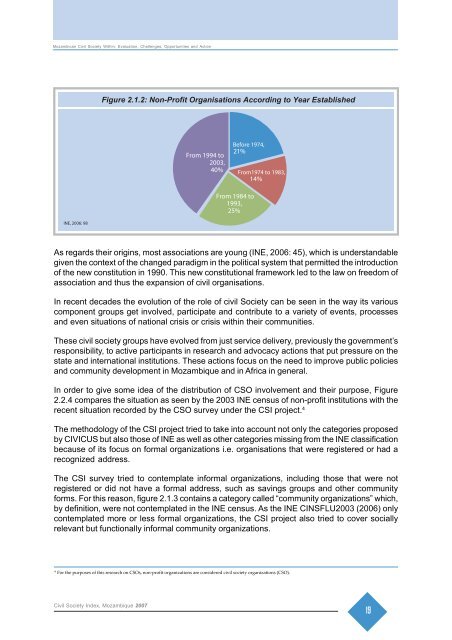Mozambican Civil Society Within: - UNICEF Mozambique - Home page
Mozambican Civil Society Within: - UNICEF Mozambique - Home page
Mozambican Civil Society Within: - UNICEF Mozambique - Home page
You also want an ePaper? Increase the reach of your titles
YUMPU automatically turns print PDFs into web optimized ePapers that Google loves.
<strong>Mozambican</strong> <strong>Civil</strong> <strong>Society</strong> <strong>Within</strong>: Evaluation, Challenges, Opportunities and Action<br />
Figure 2.1.2: Non-Profit Organisations According to Year Established<br />
From 1994 to<br />
2003,<br />
40%<br />
Before 1974,<br />
21%<br />
From1974 to 1983,<br />
14%<br />
From 1984 to<br />
1993,<br />
25%<br />
INE, 2006: 98<br />
As regards their origins, most associations are young (INE, 2006: 45), which is understandable<br />
given the context of the changed paradigm in the political system that permitted the introduction<br />
of the new constitution in 1990. This new constitutional framework led to the law on freedom of<br />
association and thus the expansion of civil organisations.<br />
In recent decades the evolution of the role of civil <strong>Society</strong> can be seen in the way its various<br />
component groups get involved, participate and contribute to a variety of events, processes<br />
and even situations of national crisis or crisis within their communities.<br />
These civil society groups have evolved from just service delivery, previously the government’s<br />
responsibility, to active participants in research and advocacy actions that put pressure on the<br />
state and international institutions. These actions focus on the need to improve public policies<br />
and community development in <strong>Mozambique</strong> and in Africa in general.<br />
In order to give some idea of the distribution of CSO involvement and their purpose, Figure<br />
2.2.4 compares the situation as seen by the 2003 INE census of non-profit institutions with the<br />
recent situation recorded by the CSO survey under the CSI project. 4<br />
The methodology of the CSI project tried to take into account not only the categories proposed<br />
by CIVICUS but also those of INE as well as other categories missing from the INE classification<br />
because of its focus on formal organizations i.e. organisations that were registered or had a<br />
recognized address.<br />
The CSI survey tried to contemplate informal organizations, including those that were not<br />
registered or did not have a formal address, such as savings groups and other community<br />
forms. For this reason, figure 2.1.3 contains a category called “community organizations” which,<br />
by definition, were not contemplated in the INE census. As the INE CINSFLU2003 (2006) only<br />
contemplated more or less formal organizations, the CSI project also tried to cover socially<br />
relevant but functionally informal community organizations.<br />
4<br />
For the purposes of this research on CSOs, non-profit organizations are considered civil society organizations (CSO).<br />
<strong>Civil</strong> <strong>Society</strong> Index, <strong>Mozambique</strong> 2007<br />
19
















